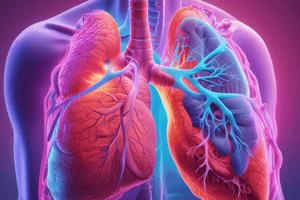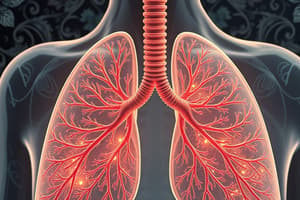Podcast
Questions and Answers
What is a potential consequence of high oxygen levels in neonates?
What is a potential consequence of high oxygen levels in neonates?
- Improved gas exchange
- Increased lung capacity
- Blood vessel formation changes (correct)
- Inadequate oxygenation
How often must the oxygen analyzer be calibrated?
How often must the oxygen analyzer be calibrated?
- After every oxygen measurement
- Whenever a cell is replaced and regularly while in use (correct)
- Weekly regardless of usage
- Only when first used
What substances interact in the oxygen analyzer to produce electrical potential?
What substances interact in the oxygen analyzer to produce electrical potential?
- KOH and O2 (correct)
- Oxygen and nitrogen
- KOH and CO2
- H2O and O2
What is a major component of a bronchoscopy system?
What is a major component of a bronchoscopy system?
What should be done when the fuel of the oxygen analyzer is depleted?
What should be done when the fuel of the oxygen analyzer is depleted?
What defines the optical channels in a bronchoscope?
What defines the optical channels in a bronchoscope?
Which type of bronchoscope is usually only used with general anesthesia?
Which type of bronchoscope is usually only used with general anesthesia?
Why is room air used as a calibration point for oxygen analyzers?
Why is room air used as a calibration point for oxygen analyzers?
What happens to the image quality if the lenses of a rigid bronchoscope are cracked or damaged?
What happens to the image quality if the lenses of a rigid bronchoscope are cracked or damaged?
Which components are included in bronchoscopy systems?
Which components are included in bronchoscopy systems?
What does ERV stand for in pulmonary function analysis?
What does ERV stand for in pulmonary function analysis?
Which parameter measures the volume of air exhaled in the first second of a forced vital capacity test?
Which parameter measures the volume of air exhaled in the first second of a forced vital capacity test?
In pulmonary function analysis, what does VC stand for?
In pulmonary function analysis, what does VC stand for?
What is the primary goal of using an incentive spirometer?
What is the primary goal of using an incentive spirometer?
What does tidal volume (VT) refer to in respiratory analysis?
What does tidal volume (VT) refer to in respiratory analysis?
What is the function of capnography monitors in respiratory assessment?
What is the function of capnography monitors in respiratory assessment?
Which device provides data for most or all parameters of the respiratory system?
Which device provides data for most or all parameters of the respiratory system?
What is the purpose of using flow transducers in pulmonary function testing?
What is the purpose of using flow transducers in pulmonary function testing?
How does impedance pneumography determine lung volume?
How does impedance pneumography determine lung volume?
Which capacity refers to the total volume of air contained in the lungs at the end of maximal inhalation?
Which capacity refers to the total volume of air contained in the lungs at the end of maximal inhalation?
What does the ratio FEV1/FVC represent in respiratory assessments?
What does the ratio FEV1/FVC represent in respiratory assessments?
What aspect of respiratory function does minute ventilation (MV) measure?
What aspect of respiratory function does minute ventilation (MV) measure?
Flashcards
ERV
ERV
Maximum exhaled air after a normal breath.
FEV1
FEV1
Exhaled air volume in first second of forced breath.
FEV1/FVC
FEV1/FVC
Ratio of FEV1 to FVC, shows lung function.
FRC
FRC
Signup and view all the flashcards
FVC
FVC
Signup and view all the flashcards
IC
IC
Signup and view all the flashcards
IRV
IRV
Signup and view all the flashcards
MV
MV
Signup and view all the flashcards
MVV
MVV
Signup and view all the flashcards
RV
RV
Signup and view all the flashcards
TLC
TLC
Signup and view all the flashcards
VC
VC
Signup and view all the flashcards
VT
VT
Signup and view all the flashcards
Incentive Spirometer
Incentive Spirometer
Signup and view all the flashcards
Graphing Spirometer
Graphing Spirometer
Signup and view all the flashcards
Pulmonary Function Analyzer
Pulmonary Function Analyzer
Signup and view all the flashcards
Respiration Monitors
Respiration Monitors
Signup and view all the flashcards
Impedance Pneumography
Impedance Pneumography
Signup and view all the flashcards
Capnography Monitors
Capnography Monitors
Signup and view all the flashcards
Capnograph
Capnograph
Signup and view all the flashcards
Oxygen Analyzers
Oxygen Analyzers
Signup and view all the flashcards
Bronchoscopy Systems
Bronchoscopy Systems
Signup and view all the flashcards
Study Notes
Respiratory System Diagnostics
- Pulmonary Function Analyzers are used to measure different aspects of respiratory function, including volumes and flow rates.
- ERV (Expiratory Reserve Volume): The maximum amount of air that can be exhaled after a normal breath.
- FEV1 (Forced Expiratory Volume in 1 second): The volume of air exhaled in the first second of a forced vital capacity (FVC) test.
- FEV1/FVC: The ratio of FEV1 to FVC, expressed as a percentage.
- FRC (Functional Residual Capacity): The amount of air remaining in the lungs after a normal breath.
- FVC (Forced Vital Capacity): The maximum amount of air that can be exhaled after a full inhalation.
- IC (Inspiratory Capacity): The maximum volume of air that can be inhaled after a normal breath.
- IRV (Inspiratory Reserve Volume): The maximum amount of air that can be inhaled after a full inhalation.
- MV (Minute Ventilation): The total volume of air exhaled per minute.
- MVV (Maximum Voluntary Ventilation): The maximum volume of air that can be breathed per minute by voluntary effort.
- RV (Residual Volume): The amount of air remaining in the lungs after a maximal exhalation.
- TLC (Total Lung Capacity): The total amount of air the lungs can hold after a maximal inhalation.
- VC (Vital Capacity): The volume of air that can be expelled from the lungs after a maximal inhalation.
- VT (Tidal Volume): The volume of air inhaled and exhaled during a single breathing cycle.
- Incentive Spirometer: A simple device that helps patients to keep up breathing exercises.
- Graphing Spirometer: A more complex spirometer that measures volume, pressure, and flow rates.
- Pulmonary Function Analyzer (PFA): Uses flow transducers and a computer system to analyze respiratory function.
- Respiration Monitors: Used to detect variations in impedance of the chest, which can be used to monitor respiration.
- Impedance Pneumography: Uses a weak electrical current to measure changes in impedance across the chest, which can be used to monitor respiration.
- Capnography Monitors: Measure the levels of carbon dioxide in exhaled breath.
- Capnograph: Uses an infrared sensor to measure CO2 levels in exhaled breath.
- Oxygen Analyzers: Measure the levels of oxygen in gases or liquids.
- Bronchoscopy Systems: Allows for visual examination of the upper respiratory system using a bronchoscope.
- Bronchoscope: A tube-like instrument with optical channels, hollow sections, and a camera sensor to view and perform procedures within the respiratory system.
Bronchoscope Types
- Flexible bronchoscopes: Thinner and more flexible, allowing them to reach further into the bronchial passages.
- Rigid bronchoscopes: Allow for the introduction of instruments for biopsies, dilations, or burning of small growths.
- Distal imaging: Some new bronchoscopes have imaging chips mounted on the distal end, eliminating some transmission problems associated with traditional fiber optics.
Studying That Suits You
Use AI to generate personalized quizzes and flashcards to suit your learning preferences.




